| Srl | Item |
| 1 |
ID:
055926
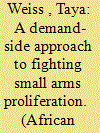

|
|
|
| 2 |
ID:
020107
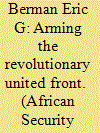

|
|
|
|
|
| Publication |
2001.
|
| Description |
5-14
|
|
|
|
|
|
|
|
|
|
|
|
|
|
|
|
| 3 |
ID:
052239
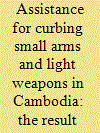

|
|
|
| 4 |
ID:
083385


|
|
|
|
|
| Publication |
2008.
|
| Summary/Abstract |
In 2001-2004 Bulgaria and Romania led internationally sponsored small arms and ammunition destruction. A few years later, they all but disappeared from destruction discussions. How to explain the enigma of these two countries' initial and large-scale action and their later hesitation? Both cases reveal the importance of external actors in small arms disarmament, in this case, especially the United States. It was Washington that created the initial demand for weapons destruction, as well as later export demands through war in Afghanistan and Iraq. While host authorities in Bulgaria and Romania may want to destroy at least part of their surplus stocks, they seem unwilling to make significant investments of their own. Convincing them to take ownership of the problem and solutions must be the next major objective of donor countries. The two countries are far from identical. Bulgaria has been more transparent, making informative reports on small arms policy to the United Nations and aiding foreign research into its small arms situation. It has shown somewhat greater interest in the disposal of surplus stocks, designating weapons for future destruction. Romania has been considerably more secretive; only limited information has been made available and the future of its weapons policies is much more obscure. But Romania has created a more reliable basis for future surplus destruction by reducing its armed forces more dramatically, especially its reserve rolls. Bulgaria seems more likely to resume destruction of surpluses, but Romania is likely to eliminate more when it gets around to it.
|
|
|
|
|
|
|
|
|
|
|
|
|
|
|
|
| 5 |
ID:
008630


|
|
|
|
|
| Publication |
May 1995.
|
| Description |
143-161
|
|
|
|
|
|
|
|
|
|
|
|
|
|
|
|
| 6 |
ID:
001021
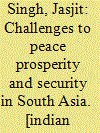

|
|
|
|
|
| Publication |
New Delhi, IDSA, 1998.
|
| Description |
181p.
|
| Contents |
Project : Peace, Security and Economic Co-operation for growth : India and South Asia in the 21st century
|
|
|
|
|
|
|
|
|
|
|
|
Copies: C:1/I:0,R:0,Q:0
Circulation
| Accession# | Call# | Current Location | Status | Policy | Location |
| 040546 | 355.033054/SIN 040546 | Main | On Shelf | General | |
|
|
|
|
| 7 |
ID:
057526
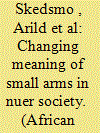

|
|
|
| 8 |
ID:
058208
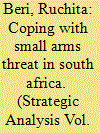

|
|
|
| 9 |
ID:
078823
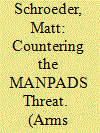

|
|
|
| 10 |
ID:
068203


|
|
|
| 11 |
ID:
114273
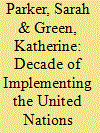

|
|
|
|
|
| Publication |
New York, UNIDIR, 2012.
|
| Description |
xxxii, 445p.Pbk
|
| Series |
UNIDIR/2012/2
|
|
|
|
|
|
|
|
|
|
|
|
Copies: C:1/I:0,R:0,Q:0
Circulation
| Accession# | Call# | Current Location | Status | Policy | Location |
| 056730 | 327.174/PAR 056730 | Main | On Shelf | General | |
|
|
|
|
| 12 |
ID:
069010
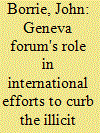

|
|
|
| 13 |
ID:
108964
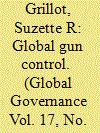

|
|
|
|
|
| Publication |
2011.
|
| Summary/Abstract |
The global spread and misuse of small arms is one of the most alarming and growing security issues of the post-Cold War era. For many reasons, however, controlling the spread of small arms is extremely difficult. Nonetheless, given the serious nature of the small arms issue, numerous states, nongovernmental organizations, and individual activists have sought to address various small arms problems. One of the earliest suggestions that analysts and advocates offered was to develop international norms and standards of behavior that outline the parameters of acceptable small arms activities. Despite the numerous actions that states and NGOs have taken over the past ten years in an effort to combat these problems, corresponding norms are relatively weak or nonexistent. This article seeks to answer why this is the case. It examines why global small arms control norms are largely weak or nonexistent and explains why the prospects for stronger norms are few. Although research on norms in international relations is swelling with studies showing whether, how, and why norms emerge and affect state behavior, few studies focus on cases where norms actually do not emerge or influence action. The primary explanation for weak small arms norms is a competitive normative environment that is facilitated and perpetuated by: (1) competing coalitions that promote opposing norms and ideas and (2) a great-power consensus that works against stronger arms control norms.
|
|
|
|
|
|
|
|
|
|
|
|
|
|
|
|
| 14 |
ID:
067164
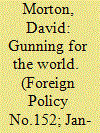

|
|
|
| 15 |
ID:
046714
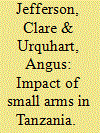

|
|
|
|
|
| Publication |
Pretoria, Institute of Security Studies, 2002.
|
| Description |
xviii, 83p.Pbk
|
| Standard Number |
1919913149
|
|
|
|
|
|
|
|
|
|
|
|
Copies: C:1/I:0,R:0,Q:0
Circulation
| Accession# | Call# | Current Location | Status | Policy | Location |
| 045727 | 683.4096780723/JEF 045727 | Main | On Shelf | General | |
|
|
|
|
| 16 |
ID:
083381
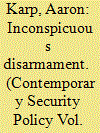

|
|
|
|
|
| Publication |
2008.
|
| Summary/Abstract |
Small arms disarmament is reshaping the global distribution of firearms, light weapons and ammunition. It is far from comprehensive, but much more than cosmetic. Its importance has been widely recognized, but seldom evaluated. The case studies in this volume examine the politics of when surpluses actually get destroyed. When, they ask, is surplus destruction most likely? And what can be done to make destruction more likely?
Perhaps the key characteristic shaping small arms disarmament is it has not been treaty-driven. Much of the trouble comparing small arms disarmament to better known programmes comes from the informal nature of these processes. The low visibility also is a side effect of the low visibility of small arms politics generally, typically the responsibility of mid-level officials, with high-level officials mostly playing ceremonial roles. But inconspicuous does not mean unimportant. Small arms and ammunition destruction directly affects prospects for future violence. By eliminating the weapons most likely to be used, it directly limits the dangers of violent crime and terrorism, and inhibits the descent into warfare.
|
|
|
|
|
|
|
|
|
|
|
|
|
|
|
|
| 17 |
ID:
075121
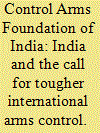

|
|
|
|
|
| Publication |
DelhI, Oxfam (India) Trust, 2006.
|
| Description |
109p.
|
|
|
|
|
|
|
|
|
|
|
|
Copies: C:1/I:0,R:0,Q:0
Circulation
| Accession# | Call# | Current Location | Status | Policy | Location |
| 051950 | 327.17409540/CON 051950 | Main | On Shelf | General | |
|
|
|
|
| 18 |
ID:
021909
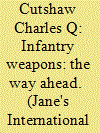

|
|
|
|
|
| Publication |
July 2002.
|
| Description |
47-53
|
|
|
|
|
|
|
|
|
|
|
|
|
|
|
|
| 19 |
ID:
093120
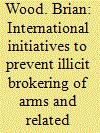

|
|
|
| 20 |
ID:
083387
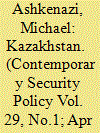

|
|
|
|
|
| Publication |
2008.
|
| Summary/Abstract |
Why does Kazakhstan not have a surplus arms and ammunition policy? Contradictory events and extreme official reticence show instead that the government of Kazakhstan does not know what to make of the issue. Despite its extensive engagement in UN processes, years of prodding from NATO and the OSCE, and the existence of its large legacy arsenals from the Soviet era, attitudes in Astana remain elusive. The Kazakhstan experience shows that for any country to act in regards to surplus arms, at least one of two factors must be present: A recognition that the surplus is a problem, or perception of benefits that can accrue by the disposal of SALW. The case of Kazakhstan exemplifies the importance of addressing two issues: surplus-is-not-a-problem and the nature of national decision-making. Internal dynamics within the Kazakhstan government have relegated the surplus issue into a non-problem.
|
|
|
|
|
|
|
|
|
|
|
|
|
|
|
|